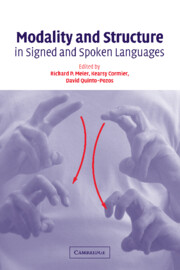Book contents
- Frontmatter
- Contents
- List of figures
- List of tables
- List of contributors
- Acknowledgements
- 1 Why different, why the same? Explaining effects and non-effects of modality upon linguistic structure in sign and speech
- Part I Phonological structure in signed languages
- Part II Gesture and iconicity in sign and speech
- Part III Syntax in sign: Few or no effects of modality
- Part IV Using space and describing space: Pronouns, classifiers, and verb agreement
- Index
Part IV - Using space and describing space: Pronouns, classifiers, and verb agreement
Published online by Cambridge University Press: 22 September 2009
- Frontmatter
- Contents
- List of figures
- List of tables
- List of contributors
- Acknowledgements
- 1 Why different, why the same? Explaining effects and non-effects of modality upon linguistic structure in sign and speech
- Part I Phonological structure in signed languages
- Part II Gesture and iconicity in sign and speech
- Part III Syntax in sign: Few or no effects of modality
- Part IV Using space and describing space: Pronouns, classifiers, and verb agreement
- Index
Summary
The hands of a signer move within a three-dimensional space. Some signs contact places on the body that are near the top of the so-called signing space. Thus, the American Sign Language (ASL) signs FATHER, BLACK, SUMMER, INDIA, and APHASIA all contact the center of the signer's forehead. Other signs contact body regions low in the signing space: RUSSIA, NAVY, and DIAPER target locations at or near the signer's waist. Still other signs move from location to location within space: the dominant hand of SISTER moves from the signer's cheek to contact with the signer's nondominant hand; that nondominant hand is located in the “neutral space” in front of the signer's torso. In the sign WEEK, the dominant hand (with its extended index finger) moves across the flat palm of the nondominant hand. As these examples indicate, articulating the signs of ASL requires that the hands be placed in space and be moved through space.
Is this, however, different from the articulation of speech? The oral articulators also move in space: the mouth opens and closes, the tongue tip and tongue body move within the oral cavity, and the velum is raised and lowered. Yet the very small articulatory space of speech is largely hidden within our cheeks, meaning that the actions of the oral articulators occur largely (but not entirely) out of sight. In contrast, the actions of the arms and hands are there for everyone to see.
- Type
- Chapter
- Information
- Modality and Structure in Signed and Spoken Languages , pp. 321 - 328Publisher: Cambridge University PressPrint publication year: 2002



